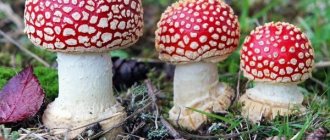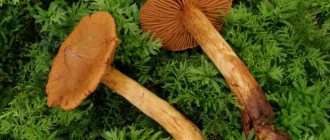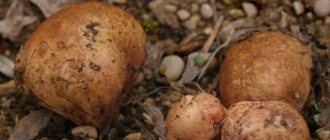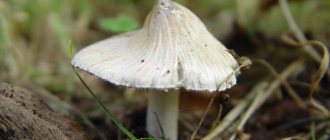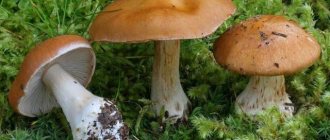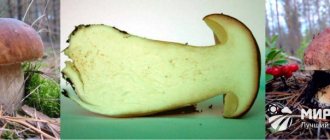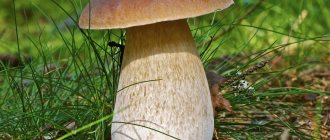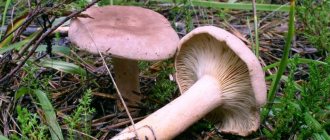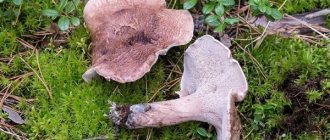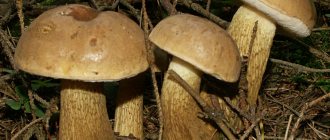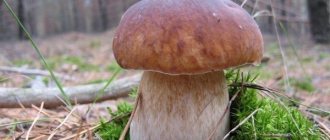Botanical description
False puffballs are gasteromycetes, that is, they are characterized by a closed structure of fruiting bodies. The fruiting bodies of these mushrooms form underground and then come to the surface to ripen. After emerging from the ground, the fruiting bodies take the shape of a tuber or ball.
Scleroderma are fungi without legs as we know them, but sometimes they can form a false stalk, which consists of connective tissue strands. Ripe puffballs can reach sizes up to 8 cm in diameter.
Young puffballs are covered with a smooth outer shell (peridium) that is white or milky in color. As it matures, the shell of the mushroom darkens and becomes rougher. The peridium of mature mushrooms is dense, yellowish or reddish in color, leathery, which formed the basis for their Latin name - “scleroderma”.
The pulp (gleba) of scleroderma is dense, hard, fleshy, and has a lacunar structure. Spores mature in the gaps, and as they mature, the gleba darkens to black. Young puffballs have white flesh when cut, mid-ripe mushrooms have marbled flesh, and ripe mushrooms have dark flesh. A hole appears at the top of the ripe mushroom to release spores.
Synonymsedit
According to the classification of E Larsson and M Jeppson, based on molecular phylogenetic studies in 2008, Vascellum arvensis is included in the subgenus Vascellum within the genus Lycoperdon4. According to the 10th edition of the “Dictionary of Fungi”, the genus Vascellum is included in the synonymy of Lycoperdon
- Bovista queletii Schulzer De Toni, 1888
- Calvatia depressa Bonord ZMoravec, 1954
- Globaria queletii Schulzer, 1885
- Lycoperdon caelatum Fr, 1829
- Lycoperdon depressum Bonord, 1857
- Lycoperdon gemmatum var pratense Pers J. Schröt, 1889
- Lycoperdon hyemale Bull, 1781
- Lycoperdon kalchbrenneri De Toni, 1888
- Lycoperdon natalense Cooke & Massee, 1887
- Lycoperdon vitellinum Fr, 1817
- Utraria pratensis Pers Quél, 1873
- Vascellum depressum Bonord FŠmarda, 1958
- Vascellum pratense Pers Kreisel, 1962
Types of false raincoats
There are more than 20 species in the genus of false raincoats. On the territory of Russia you can find seven species of scleroderma, of which the most common are the common puffball and the verrucous.
Common puffball
The fruiting body of the mushroom has the shape of an egg with a diameter of 3 to 6 cm. The shell is thick, dotted with scales and cracks. The surface color ranges from yellow-orange to orange-brown. Their false pedicle is not pronounced and is often absent.
The pulp of scleroderma vulgaris in young specimens is light in color and turns red after cutting. In ripe mushrooms, it breaks up into grayish dense areas and green-brown spore powder. The smell of young scleroderma is similar to the smell of raw potatoes. The pulp is inedible and can cause food poisoning. Fungal spores can trigger allergic reactions.
Common false raincoats grow on the wood of deciduous and coniferous forests and forest plantations. They prefer sandy soils and moss-covered areas.
False puffball warty
The body of this species of mushroom has the shape of a tuber or bud up to 8 cm in diameter. The mushroom has a false stalk, which is often buried in the soil. The shell of the warty scleroderma is thin, covered with wart-shaped outgrowths. The color of the mushroom changes as it ripens, from off-white to yellow-brown.
The pulp of young specimens is dense, white with yellow veins, while in mature specimens it is gray-black and powdery. The smell of the pulp is unpleasant. The mushroom is inedible. May cause food poisoning, in severe cases with signs of damage to the nervous system (convulsions, loss of consciousness).
Scleroderma warty often grows on the bark of deciduous trees, as they form mycorrhizae with them. They can also be found on sandy soils with the top layer removed, among rare grasses.
Spreading
False raincoat orange.
Common false puffball is the most common and widespread of all false puffballs. It grows in Russia (European part, North Caucasus and Far East).
It is a saprotroph and grows on rotten trees and soil rich in humus. The mushroom prefers light forests, heathers, roadsides and clearings. Can grow in moss and on sand, singly or in groups. The parasitic moss fly often grows on it.
The growth period is from mid-summer to mid-autumn.
Differences between false raincoats and real ones
False puffballs are inedible mushrooms, but if eaten in large quantities they can cause food poisoning. To prevent this from happening, any novice mushroom picker needs to know the main differences between false raincoats and real ones:
- Scleroderma usually grow in groups, while true puffballs grow singly.
- The outer shell of scleroderma is leathery, dense, with cracks, while in true raincoats it is thin and delicate.
- The color of the periderm of false puffballs is brown, orange or yellow. Real raincoats have a light shell color.
- Real raincoats have spines on the surface. There are no such outgrowths at the peridium of false puffballs.
- The flesh of false mushrooms is dense to the touch, while that of real mushrooms is soft but elastic.
- Ripe scleroderma smells unpleasant.
- When cut, the flesh of a mature inedible mushroom becomes dark in color, but remains dense.
To determine whether the puffball is edible, you need to cut or break the body of the mushroom. White pulp and a pleasant mushroom smell are a sign that the puffball is edible.
What harm do parasites cause to the host?
Symbiosis does not always lead to the death of one organism. In most cases, the parasite benefits from the survival of its host. But poisoning by metabolic products or tissue destruction most often leads to illness and death of the individual. Insects – parasites of animals – cause the least harm. But constant itching from the presence of mites or lice, damage to the coat or feathers of birds leads to decreased performance and greater accessibility of the individual to predators.
Parasites of domestic animals are especially dangerous for humans, as they can infect them. These include, first of all, various helminths that cause damage to internal organs, poisoning by waste products and deterioration of health.
Chemical composition
The pulp of false puffballs is rich in protein compounds. In addition to proteins, the mushroom glebe contains carbohydrates (mainly polysaccharides), fats, vitamin A, group B, minerals (potassium, phosphorus, sodium, calcium, iron, copper, zinc, iodine, arsenic), organic acids (oxalic, fumaric, citric, tartaric), phytotoxins, pigments (sclerocitrin).
The pulp of scleroderma also contains a unique substance - calvacin (salt of calvacic acid). The bitterness they contain in large quantities, as well as the dark, foul-smelling pulp, make the false puffballs inedible.
Fart mushrooms. Wolf fart, partridge leg and cow tongue
Do you know what this is? If interested, go to cat. There's also something about the king's egg, the pipes of the dead, and even something more fun. The folk language always amazes with its imagery and accuracy. So we saw a stale puffball mushroom in the forest, we slammed our foot on it, and a grayish smoke of spores flew out of it. Why not a wolf fart? If he is still young and white, dense, then his ugly name will not prevent him from being sent to the frying pan along with his brothers.
In Spain they love and know how to collect mushrooms no less than we do. And they even roam around the forest with some instruments. I don’t know exactly what kind of device it is, but they show on TV: a man walks and walks, looks not at his feet, but at the device, then - bam! - and went to the mushroom. In general, as elsewhere, porcini mushrooms are most valued; they are called there by the Latin name boletus and can cost up to 120 euros per kilo on the market. There are a lot of saffron milk caps, and two varieties. They are even sold in jars in supermarkets. But there is also something more exotic - mushrooms that seem unlikely to be found in central Russia (if you have, tell us). Well, for example, one of the most delicious mushrooms is the king's egg, otherwise known as Caesar's mushroom. It is from the same genus as the toadstool and fly agaric, from the Amanitidae, but is edible to such an extent that it can be eaten raw. But I didn’t come across them, and even if I did, it’s still a little scary, even if it’s not easy to confuse them with their dangerous relatives.
But partridge leg (pie de perdiz) can also be found in Russia under the no less funny name - purple mokrukha.
Eric Steinert Trumpets of the dead or trumpets of death (Trompeta de la muerte or trompeta de los muertos), despite the ominous appearance and name, is a completely edible, tasty and valuable mushroom. During the season it can be found in markets and supermarkets fresh, and out of season - dried. I haven’t met one in the forest, but there are chances. In Russia, it is simply called a gray fox, in fact, this is what a fox is.
Cow's (or in some regions cat's) tongue is considered very delicious when young, until it acquires excessive hardness and bitterness. I came across him quite often, and it seems that both in Russia and in Spain, but - it’s all due to my past ignorance - he inspired primitive horror. Now we need to somehow correct this omission and find it again somewhere. In Russian it is called hedgehog, so it is not only the Spaniards who evoke animalistic associations.
There is another rather exotic-looking mushroom - cardo, translated as thistle, burdock, but this word is used to describe many different plants in Spain, including edible ones. And although Wikipedia claims that in Russian it will be “steppe oyster mushroom,” I am tormented by vague doubts due to some dissimilarity between these species. True, variability, especially depending on the growing zone, is not uncommon in the kingdom of mushrooms. Of course, mushrooms are not found everywhere in Spain. In the fall, sometimes you can find umbrellas, champignons or honey mushrooms even in city parks, but if we are talking about a mushroom hunting trip, then you need to go to the mountains, to the heights of coniferous forests with good undergrowth. Fortunately, there are many such mountains in almost any autonomous community. We usually went for mushrooms to the Sierra de Guadarrama near Madrid. Picking mushrooms in those parts is a very sporting activity, because you have to constantly go up and down slopes and along streams. But it’s still pleasant, and the result is boletus, white mushrooms, saffron milk caps and honey mushrooms.
Butterflies are very different in appearance from what we are used to in Russia, and as for honey mushrooms, they are not considered particularly edible there at all. They have thick and almost stiff legs, and hats the size of a good umbrella.
For lovers of mushroom picking, mycological tours are organized in the fall, with an educational program on the types of edible and inedible mushrooms and tasting of mushroom dishes in local rural restaurants. There are places where “wild” mushroom pickers are not welcome. At least when a group of several dozen Romanian gypsies with trucks camps in a protected area and clears out mushroom resources to the roots within a week. But in any case, there are many opportunities to satisfy your passion for quiet hunting in Spain, with all respect for the environment. Oh, yes, fun is promised. I just can’t pass by and not mention it. In Spain, such a mushroom, even if it grows, is not particularly valued (unlike even neighboring France), but in Russia, they say, it is collected. It’s called Veselka ordinary, and it’s very Russian: allegorical and clever. And fun, of course. In all other languages, starting with Latin, it is called without equivocation: shameless phallus. (And how can we not remember the sensational program of Kuryokhin and Sholokhov about “Lenin’s Mushroom” in the early 90s?) I didn’t come across it, which is a pity. I'd really like to have some fun.
Beneficial features
Calvacin contained in the mushroom has antibiotic and antifungal effects. The anticancer effect of calvacin was experimentally proven: in experiments on animals with cancerous tumors, consuming the pulp of these mushrooms reduced the size of tumors. Fresh puffball pulp has the ability to stop capillary bleeding, fight skin diseases, and relieve local inflammation.
Young scleroderma are vaguely reminiscent of truffles in taste and smell, so gourmets sometimes use them in cooking as a spicy seasoning.
However, it is necessary to add them in very limited quantities so as not to provoke digestive disorders.
Treatment of scleroderma
Currently, scleroderma is an incurable disease. However, modern therapy allows him to remain in long-term remission. The amount of treatment depends on the degree of activity of scleroderma, damage to internal organs, and clinical manifestations.
The choice of course of therapy is made by the attending physician based on diagnostic studies. The Moscow Yusupov Hospital has been treating scleroderma for many years. Highly qualified rheumatologists select individual therapy according to the degree of disease activity. Treatment is carried out in accordance with the latest international recommendations for the treatment of chronic autoimmune diseases.
Harmful properties
The pulp of the puffball contains phytotoxins. Their concentration in mushrooms is low, so if one or two mushrooms are consumed, they can cause food poisoning or digestive upset.
When eating a large amount of scleroderma, signs of intoxication appear with characteristic symptoms of damage to the nervous system:
- dizziness;
- headache;
- impaired sensitivity of the skin of the extremities;
- perversion of taste sensations;
- decreased visual acuity;
- loss of consciousness.
When spores of the puffball get on the mucous membranes (eyes, nasopharynx), allergic reactions or reactive rhinitis, conjunctivitis may occur.
Interesting Facts
Lemon puffball.
- If you eat this mushroom in large quantities (2-3 pieces of a young specimen is considered a safe amount), poisoning may occur. It is manifested by pain in the epigastric region, vomiting and nausea, weakness, visual disturbances and loss of sensation in the legs.
- If such symptoms occur after consuming a false raincoat, you need to drink a large amount of water and induce vomiting. It is also necessary to immediately call for medical assistance. Due to the risk of poisoning, it is not recommended to collect and eat puffballs.
Use in folk medicine
Traditional medicine has found the use of false raincoats in the treatment of dermatological diseases, wounds and injuries of the skin. For this purpose, both young and mature mushrooms are used. Slices of young mushrooms are applied to the problem area of the skin for several hours, putting a bandage on it, then the slice is changed.
If young scleroderma are difficult to find, mature specimens can be used. Then the affected area of skin is sprinkled with mushroom spores. Sprinkling with spores of ripe scleroderma is used as a remedy for trophic ulcers and purulent wounds.
This external use of a false raincoat promotes wound healing and stops bleeding, stimulates the regeneration of the epidermis, and dries out weeping wounds.
Preparations from false puffballs are used orally in the treatment of cancer. They are used in the form of a decoction of fresh pulp, an alcohol tincture of dried mushrooms or a tincture of mature spores.
Decoction of fresh puffballs
Several specimens of crushed fresh scleroderma are poured into 0.5 liters of boiling water, boiled for 30 minutes, left to cool, and filtered. Take 0.5 cups three times a day.
Scleroderma tincture
2 tablespoons of powdered dry mushrooms or their spores are poured with 150 ml of alcohol or vodka, infused in a dark place for 2 weeks. Take a teaspoon three times a day before meals.
The use of folk remedies from false raincoats does not replace the main oncological treatment, so they cannot be perceived as a panacea for cancer.
Scleroderma-based products should be used in the complex treatment of neoplasms only with the permission of an oncologist.
Contraindications
The fruiting bodies of false mushrooms contain bioactive components: palmitic and oleic fatty acids, ergosterol peroxide, dimethylphenylalanine. The pulp of the puffball also contains complex protein compounds and fumaric acid. The latter contains a large amount of calvacin, which is a natural means of inhibiting the growth of cancer cells.
This allows scleroderma to be used in medicine. Tests carried out on animals have proven that thanks to fungotherapy, malignant tumors in animals have decreased in size by 2 times. Therefore, preparations based on calvacin are used to treat patients with cancer and sarcoma.
People use fruiting bodies to treat the following diseases:
- oncology;
- inflammatory processes;
- swelling of soft tissues;
- skin diseases (psoriasis).
Did you know? If we consider the way mushrooms feed, they are more like animals: they do not have chlorophyll and feed on ready-made organic matter.
In addition to useful substances, these fungal organisms contain dangerous resin-like substances, ketones and aldehydes, which irritate the gastrointestinal mucosa . In some cases, they can cause the development of resinoid syndrome. Even edible puffball can be harmful to the human body, as it is difficult to digest. Therefore, it is not recommended for use by nursing or pregnant women, as well as children under 5 years of age. Caution should be exercised by people with diseases of the pancreas and kidneys.
Thanks to reading this article, it was possible to establish that the false puffball is a mushroom that is not intended for widespread culinary use. Although in folk medicine it is used to treat some skin and internal diseases.
False puffball (Scleroderma)
False raincoat (scleroderma) should not be collected. In most books of the Soviet period, this mushroom is considered inedible or poisonous. Western authors only call it inedible, specifying that cooks sometimes add pulp to sausages instead of truffles. They all warn that puffballs can be hazardous to health if eaten in large quantities.
I have not tried this mushroom, so I can only refer to the opinions of authoritative mushroom experts. I quote them verbatim.
The false puffball, which they scare us with in all the books about mushrooms, is not at all poisonous, even in its raw form. It is simply tasteless, and according to the rules it should be classified as an inedible mushroom. Moreover, young false puffball (when the flesh is white when cut) has a sharp, spicy taste and can serve as a piquant seasoning for meat and poultry dishes. This is exactly how it is used in Europe, especially in Slavic countries. The final inedibility of the false puffball occurs from the moment its flesh ceases to be pure white when cut. (M. Vishnevsky).
Let me remind you once again: false puffballs are poisonous, however, only if you eat them in large quantities. In the Czech guide to mushrooms of J. Klan it is written that “for the sake of a strong spicy taste, young mushrooms are used instead of roots in the preparation of soups and sauces.” These are truly inscrutable human whims! For the sake of an exotic taste, sacrifice the health of your stomach? (M. Sergeeva).
We conclude: the degree of poisoning by false puffballs depends, first of all, on the number of mushrooms eaten.
False puffballs are easy to distinguish from edible species. False puffballs usually have warty-scaly, dense skin of a yellowish-ochre color, which may have small cracks. In older mushrooms, the skin dries out, breaks, and no longer holds the spores underneath.
False raincoats often grow in nests (photo from Wikipedia)
The color of the flesh of young mushrooms, according to most authors, is yellowish or light olive even at a young age. A marble pattern with white veins can be seen on it. The central part of the false puffball darkens as it matures, first becoming gray-violet, then almost black. The pulp of even adult puffballs retains its density. Everyone notes an unpleasant, pungent odor.
Mushroom pickers who have not collected puffballs before should not take risks and not collect mushrooms with elongated false legs that grow in nests. To be on the safe side, it is better not to take raincoats with clearly yellow or brown skin. Especially when it is covered with rough growths and has noticeable cracks. The unpleasant smell should also stop.
A relative of the orange puffball
The puffball is also a relative of the orange puffball. This mushroom has a fruiting body similar to a tuber, but it is elongated at the top. When growing, the orange puffball reaches a height of 10 cm. Its upper part has an ocher or yellowish tint.
As it grows, it cracks and “warts” appear on it. At the bottom, this mushroom is narrowed and wrinkled, and its flesh is white. Orange puffball is an inedible mushroom, but some fans add small amounts of it to other mushrooms because when cooked it has an aroma vaguely reminiscent of truffles.
